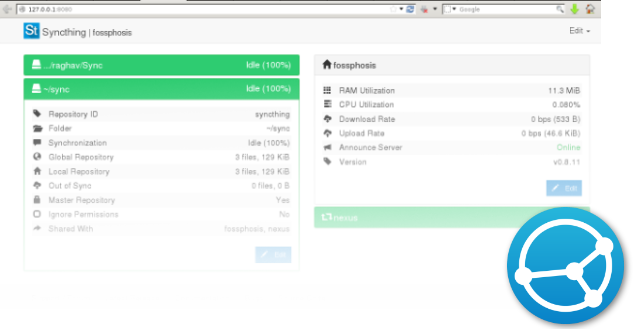

- Syncthing over internet full#
- Syncthing over internet portable#
- Syncthing over internet software#
- Syncthing over internet download#
- Syncthing over internet free#
I just have it in a folder in my user ‘Documents’ folder. On Github, you can grab QSyncthingTray for either Windows or OS X.Įnsure you unzip and add the Syncthing server files somewhere you’ll remember, as you’ll need that information later. Being an open source project, there are plenty of options to choose from, but I found this one is fairly cross-platform so should meet most people’s needs.

Syncthing over internet download#
Preparationįirst, download both the Syncthing server and the QSyncthingTray front end for any computers you want synced.
Syncthing over internet software#
Both parts of the software are still in active development, so there will be changes, but the fundamentals should stay the same. There are plenty of apps that allow you to access the GUI by running in your system tray / taskbar and providing a wrapper to launch the server. At its most basic, Syncthing is a locally run server with a web-based front end that lets you change the settings, whitelisted devices, and folders. There’s a ‘ getting started‘ guide over on the official site that can get a bit technical, but here’s my process for setting up the software as of mid-January 2015. The software supports backing up just changes (ie new files), so it’s ideal for ensuring your library stays in parity. While a tad fiddly to set up initially, once it’s up and running Syncthing has low overhead, and you only need to run it once in a while after something changes to keep any new files in sync on the secondary computer. That’s the hard sell from the project’s website. Your data is your data alone and you deserve to choose where it is stored, if it is shared with some third-party and how it’s transmitted over the Internet. Syncthing replaces proprietary sync and cloud services with something open, trustworthy and decentralized. If you’re on OS X, Time Machine is a decent enough system and it comes with the OS. Regardless of the risk, it’s always good practice to keep a spare up-to-date copy of your files that will be safe should your laptop bite the dust. I’ll be using OS X and Traktor as my example to set up, since that’s what I’ve got, though Syncthing works for anything from Windows, OS X and Linux… right through to FreeBSD and Solaris.įirst things first… always back up your computer before you start. I’ve mentioned before that I’m a big fan of open source software, so imagine my excitement as I read through the features of the software. Having researched various options, I turned to the Open Source community for the answer: Syncthing.
Syncthing over internet free#
There are lots of ways to keep your music synced between laptops and across various devices, from cloud syncing to peer2peer and local NAS solutions, but most cost money up front or as subscriptions, or the free options just don’t quite cut it. When I found myself with two MacBooks, one brand new and shiny, the other my seasoned DJ rig, it seemed like it should be trivial to make sure all my music and settings remained in parity across both laptops. You might have a desktop and laptop computer, or if you’re a career DJ, you might have a backup laptop which you need to keep up to date with any music library changes and software settings.
Syncthing over internet full#
It provides you with full control over the files you want to share and works over LAN or Internet without the need for any complicated IP configurations.I don’t have a huge music collection, but it’s enough to take ages to copy between storage devices, and keeping it updated on multiple devices is a nightmare. You can then select or invite other computers that are running Syncthing and choose to allow them access to your files. You start by selecting one or more folders (on your computer) that you want to share with others. It uses a browser based GUI that allows you to configure the application and monitor file sharing activity.
Syncthing over internet portable#
Syncthing is portable and does not require installation. Only computers that have been explicitly allowed can connect to your file sharing cloud. In addition, all communication is secured using TLS and every node is identified by a strong cryptographic certificate. Unlike traditional cloud services, Syncthing does not store your data anywhere else, there are no third party servers involved. Syncthing is and open and decentralized sync and cloud service that lets you share and synchronize files with other computers and provides you with full control over how your data is shared and who can access it.


 0 kommentar(er)
0 kommentar(er)
